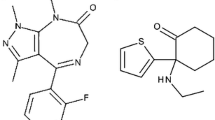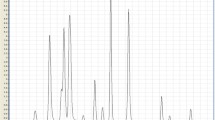Abstract
Drug testing in hair can complement conventional blood and urine analysis as it enlarges the window of detection and may allow a differentiation of heavy from moderate or rare use. Databases of drug concentrations in biological matrices are a valuable support in interpreting analytical results. In forensic toxicology, several databases exist especially for blood/serum samples. In the present paper, the concentration distributions of more than 100 legal and illegal drugs such as narcotic drugs, opioids, antidepressants, antipsychotics, benzodiazepines, and major metabolites detected in authentic Caucasian hair samples in our laboratory are summarized. Depending on availability, the proximal sections of 1–6 cm in length were analyzed by liquid chromatography/tandem mass spectrometry following extraction of the finely chopped specimens by ultrasound in methanol. The data may present a helpful basis also for other laboratories for an initial evaluation of their results. However, these statistical data should not be used uncritically without including the circumstances of the particular case and the analytical procedures used. In addition, each laboratory in charge of interpreting results from hair analysis should balance own results as far as available with this data base.
Similar content being viewed by others
References
Madea B, Musshoff F (2004) Haaranalytik, Technik und Interpretation in Medizin und Recht. Deutscher Ärzte-Verlag, Köln
Kintz P, Salomone A, Vincenti M (2015) Hair analysis in clinical and forensic toxicology. Elsevier/Academic Press, Amsterdam
Kintz P (2017) Hair analysis in forensic toxicology: an updated review with a special focus on pitfalls. Curr Pharm Design 23(2017):1–7
Musshoff F, Madea B (2007) New trends in hair analysis and scientific demands on validation and technical notes. Forensic Sci Int 165(2–3):204–215
Musshoff F, Madea B (2007) Analytical pitfalls in hair testing. Anal Bioanal Chem 388(7):1475–1479
Cooper GA, Kronstrand R, Kintz P, Society of Hair Testing (2012) Society of Hair Testing guidelines for drug testing in hair. Forensic Sci Int 218(1–3):20–24
Salomone A, Tsanaclis L, Agius R, Kintz P, Baumgartner MR (2016) European guidelines for workplace drug and alcohol testing in hair. Drug Test Anal 8(10):996–1004
Pragst F Pitfalls in hair analysis. Oral presentation at the Joint GTFCh/TIAFT Symposium “Analytical pitfalls and trends in clinical and forensic toxicology” during the Analytica Conference, May 12th, 2004 In Munich, Germany. Toxichem Krimtech 71(2004):69–83
Jurado C, Staub C (2001) Interpretation of hair analysis: Opiates. Presented at the Society of Hair Testing Workshop “Interpretation of Hair Analysis”, Bordeaux, France
Musshoff F, Padosch S, Steinborn S, Madea B (2004) Fatal blood and tissue concentrations of more than 200 drugs. Forensic Sci Int 142(2–3):161–210
Moffat AC, Osselton MD, Widdop B (2011) In: Watts J (ed) Clarke’s analysis of drugs and poisons, Fourth edn. Pharmaceutical Press, London & Chicago
Baselt RC (ed) (2014) Disposition of toxic drugs and chemicals in man, Tenth edn. Biomedical Publications, Seal Beach
Schulz M, Iwersen-Bergmann S, Andresen H, Schmoldt A (2012) Therapeutic and toxic blood concentrations of nearly 1.000 drugs and other xenobiotics. Crit Care 6(4):R136
Launiainen T, Ojanperä I (2014) Drug concentration in post-mortem femoral blood compared with therapeutic concentrations in plasma. Drug Test Anal 6:308–316
Hiemke C, Bergemann N, Clement HW, Conca A, Deckert J, Domschke K, Eckermann G, Egberts K, Gerlach M, Greiner C, Gründer G, Haen E, Havemann-Reinecke U, Hefner G, Helmer R, Janssen G, Jaquenoud E, Laux G, Messer T, Mössner R, Müller MJ, Paulzen M, Pfuhlmann B, Riederer P, Saria A, Schoppek B, Schoretsanitis G, Schwarz M, Silva Garcia M, Stegmann B, Steimer W, Stingl JC, Uhr M, Ulrich S, Unterecker S, Waschgler R, Zernig G, Zurek G, Baumann P (2018) Consensus guidelines for therapeutic drug monitoring in neuropharmacology: update 2017. Pharmacopsychiatry 51(1–2):9–62
Lee S, Han E, Park Y, Choi H, Chung H (2009) Distribution of methamphetamine and amphetamine in drug abusers’ head hair. Forensic Sci Int 190(1–3):16–18
Cordero R, Lee S, Paterson S (2010) Distribution of concentrations of cocaine and its metabolites in hair collected postmortem from cases with diverse causes/circumstances of death. J Anal Toxicol 34:543–548
Tsanaclis L, Wicks JF (2007) Patterns in drug use in the United Kingdom as revealed through analysis of hair in a large population sample. Forensic Sci Int 170:121–128
Thieme D, Sachs H (2003) Improved screening capabilities in forensic toxicology by application of liquid chromatography–tandem mass spectrometry. Anal Chim Acta 492(1–2):171–186
Peters FT, Drummer OH, Musshoff F (2007) Validation of new methods. Forensic Sci Int 165:216–224
Franz T, Skopp G, Schwarz G, Musshoff F (2018) Proof of active cannabis use comparing 11-hydroxy-∆9-tetrahydrocannabinol with 11-nor-9-carboxy-tetrahydrocannabinol concentrations. Drug Test Anal 10(10):1573–1578
Franz T, Scheufler F, Stein K, Uhl M, Dame T, Schwarz G, Sachs H, Skopp G, Musshoff F (2018) Determination of hydroxy metabolites of cocaine from hair samples and comparison with street cocaine samples. Forensic Sci Int 288:223–226
Zinka B, Epple S, Schick S, Skopp G, Graw M, Musshoff F (2019) Can a threshold for 11-nor-9-carboxy-Δ9 -tetrahydrocannabinol in hair be derived when its respective concentration in blood serum indicates regular use? Drug Test Anal 11(2):325–330
Desta Z, Moaddel R, Ogburn ET, Xu C, Ramamoorthy A, Venkata SL, Sanghvi M, Goldberg ME, Torjman MC, Wainer IW (2012) Stereoselective and regiospecific hydroxylation of ketamine and norketamine. Xenobiotica. 42(11):1076–1087
Poetzsch M, Baumgartner MR, Steuer AE, Kraemer T (2015) Segmental hair analysis for differentiation of tilidine intake from external contamination using LC-ESI-MS/MS and MALDI-MS/MS imaging. Drug Test Anal 7(2):143–149
Skopp G, Kniest A, Haisser J, Mann K, Hermann D (2011) Buprenorphine and norbuprenorphine findings in hair during constant maintenance dosage. Int J Legal Med 125(2):277–281
Author information
Authors and Affiliations
Corresponding author
Ethics declarations
Ethical approval
Ethical approval is not necessary for real retrospective studies.
Conflict of interest
The authors declare that they have no conflict of interest.
Additional information
Publisher’s note
Springer Nature remains neutral with regard to jurisdictional claims in published maps and institutional affiliations.
H. Sachs is deceased.
Rights and permissions
About this article
Cite this article
Musshoff, F., Schwarz, G., Sachs, H. et al. Concentration distribution of more than 100 drugs and metabolites in forensic hair samples. Int J Legal Med 134, 989–995 (2020). https://doi.org/10.1007/s00414-020-02259-3
Received:
Accepted:
Published:
Issue Date:
DOI: https://doi.org/10.1007/s00414-020-02259-3




